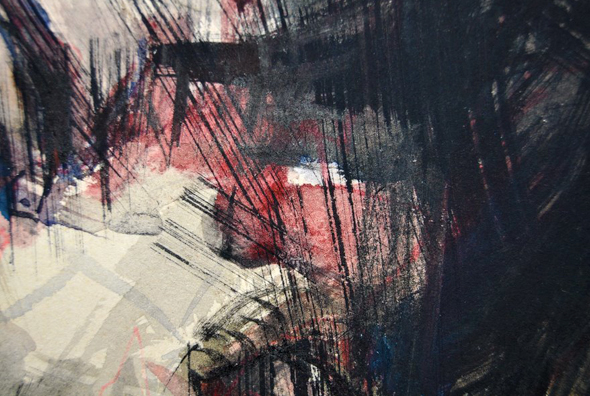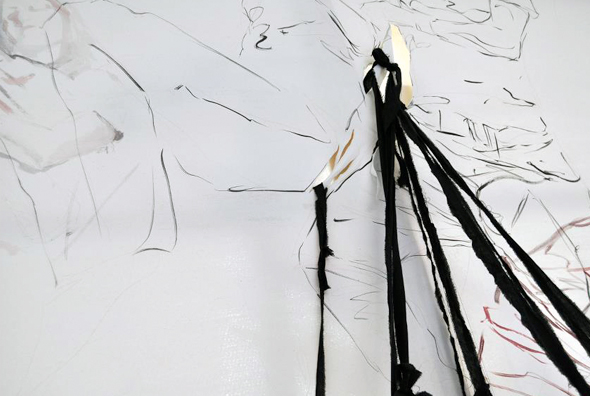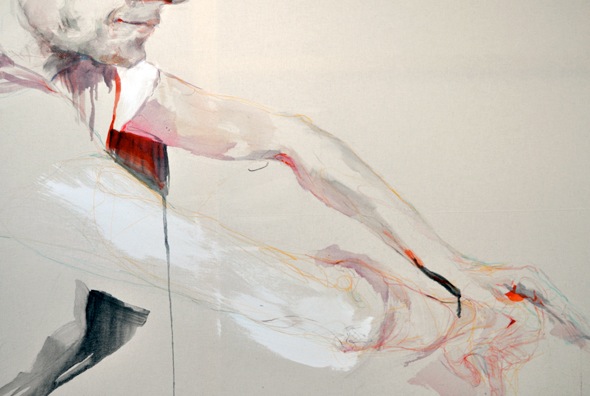 Beatriz Crespo, “Impasse”; Courtesy of the Artist
Beatriz Crespo, “Impasse”; Courtesy of the Artist
Beatriz Crespo’s solo show, Verdandi, that opened on June 22nd in Merringdham, Kreuzberg, is the first exhibition curated by German porcelain manufacturer, Porcelaingres, as part of their new art exhibition program. They are presenting a large collection of recent works by the artist, including big scale paintings as well as smaller drawings.
There are not many strokes on Crespo’s paintings. Each one has to be essential. It has to be honest and meaningful. She does care about being as honest as possible, and about seeing a job done well and chooses carefully the material she uses, and spends time experimenting with it prior to painting. The artist explores the correlation between the human condition and the properties of the medium. In a symbolist way, and sometimes an animist one, she is looking for relations between the material she uses and her subjects.
In her painting “Ludovic”, we can see the canvas on some areas. Only transparent gesso has been applied to the canvas, so that we can see its structure. Some parts of the subject’s body are missing, like his legs and most of the lower part, to focus on his head, on his thinking, and on his arms and hands, as he is a writer. She started painting as an abstract expressionist painter, when abstract painters usually start as figurative painters. Now faces emerge from her paintings. The paintings don’t represent necessarily something personal but rather what the painter understands about human condition and problems anyone encounters in their life via her knowledge of herself, of others, of her life, of life with others. The paintings focus on people and mainly on faces because those moments they capture are the ones that make us become who we are. Rather than simple portraits of people, they capture those hard moments in which we go deep in our soul, to find the strength to move forward, those moments in which we understand things about life. Crespo’s art used to be abstract and she know uses figuration to represent something abstract; the volatile intimacy of moments.
At first sight, those paintings may look sad, and when looking at the canvases from afar, they look black and white. As we get closer, we notice bits of colours. By providing obscure dashes on the painting that have a texture and a special light, obscurity is represented in a warmer way than we thought. They might symbolise something sad, with bits of hope here and there. There are some lights in total darkness, and one can find beauty in tough times.
 Beatriz Crespo, “Aphorismus”; Courtesy of the Artist
Beatriz Crespo, “Aphorismus”; Courtesy of the Artist
In her work, Aphorismus, Crespo depicts the same subject three times, a lapse of a few seconds has happened in between those three instants. The three representations of the same scene overlap each other.
By juxtaposing them, Crespo is not breaking down a movement like in a “Nude descending a staircase”, but is breaking down moments. This micro-temporal approach is dissecting the intimacy of moments. The interstitial space of the human relationships is precisely represented by a hole in the canvas from where a river of black cloth extends the passion over the showroom pulling the viewer from the literal view of the artwork into a sensual experimentation of its magical-symbolic level. Crespo paints at night, with little light, as it is more intimate. As Crespo puts it, “It is like painting within yourself”.
___________________________________________________________________________________
Additional Information
PORCELAINGRES ART SHOWROOM
Verdandi – BEATRIZ CRESPO
Exhibition: June 22nd – Sept. 5, 2012
Open hours:
Monday to Friday, from 9am to 5pm
Mehringdamm 55-57 (courtyard)
(click here for map)
BEATRIZ CRESPO artist website: www.beatrizcrespo.com
PORCELAINGRES, a porcelain stoneware manufacturer for architecture, opened its new exhibition space, intending to create a meeting place for artists and designers, and encourage debates around architecture and art.
___________________________________________________________________________________
Blog entry by Florence Reidenbach in Berlin; Monday, July 9, 2012.




















